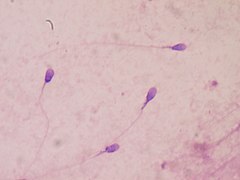有性繁殖
閱讀設定
有性繁殖(粵拼:jau5 sing3 faan4 zik6 | 英文:Sexual Reproduction)係指一個生物物種用公同乸兩個性別進行繁殖。
稍為複雜少少嘅生物,包括所有已知嘅脊椎動物,絕大多數係行有性繁殖嘅,會用公同乸兩性做繁殖:喺呢啲生物當中,公會提供精子,而乸就提供卵子,精子有阿爸嘅部份 DNA,而卵子有阿媽嘅部份 DNA;喺受精(fertilization)嘅過程入面,精子同卵子會結合,於是就產生出一個喺遺傳上有少少似阿爸、又有少少似阿媽嘅新個體[1]。
|
有性繁殖嘅起源
[編輯]好多原生生物進行有性繁殖,正如多細胞植物,動物同真菌噉樣。喺真核生物化石記錄中,有性繁殖最早出現喺大約20億年前嘅元古宙[2][3],但係後來佢嘅年代都畀確定為12億年前[4][5]。
進化起源
[編輯]對於有性繁殖嘅進化起源,廿一世紀初嘅生物學界仲有唔少爭議[6]。其中一個見解係,有性繁殖會賦予物種比較大嘅遺傳多樣性-研究表示,靠無性繁殖(asexual reproduction)所生嘅後代同母體係一個板嘅(想像一粒靠自己分裂嚟繁殖嘅細胞,後代淨係有得由母體嗰度攞遺傳物料),所以如果一個物種係靠無性繁殖嚟生新個體嘅話,個物種嘅遺傳多樣性就會低得好交關,令佢哋好多時一旦有一兩種遺傳病,就搞到成個物種受毀滅性嘅打擊;因為噉,有性繁殖喺進化上對一個物種有利[7][8]。
性選擇
[編輯]内文:性選擇
睇埋
[編輯]參攷
[編輯]- ↑ Bernstein, Harris; Bernstein, Carol; Michod, Richard E. (2011). "Meiosis as an Evolutionary Adaptation for DNA Repair Chapter 19". In Kruman editor, Inna. DNA Repair. InTech.
- ↑ Otto, Sarah P. (2008年). "Sexual Reproduction and the Evolution of Sex". 《Nature》. 喺2021年10月1號搵到.
- ↑ Zimmer, Carl (2009年6月5號). "On The Origin Of Sexual Reproduction". 《Science》. 324 (5932): 1254–1256. doi:10.1126/science.324_1254. PMID 19498143. 喺2021年10月1號搵到.
- ↑ Butterfield, Nicholas J. (2000年). "Bangiomorpha pubescens n. gen., n. sp.: implications for the evolution of sex, multicellularity, and the Mesoproterozoic/Neoproterozoic radiation of eukaryotes". Paleobiology. 26 (3): 386. doi:10.1666/0094-8373(2000)026<0386:BPNGNS>2.0.CO;2. S2CID 36648568. 喺2021年4月12號搵到.
- ↑ Cumming, Vivian (2016年7月4號). "The Real Reasons Why We Have Sex". BBC News. 喺2021年4月12號搵到.
- ↑ Hörandl, Elvira (2013). "Meiosis and the Paradox of Sex in Nature". In Bernstein, Carol. Meiosis. InTech.
- ↑ Otto, SP; Gerstein, AC (August 2006). "Why have sex? The population genetics of sex and recombination". Biochemical Society Transactions. 34 (Pt 4): 519–22.
- ↑ Agrawal, AF (September 2006). "Evolution of sex: why do organisms shuffle their genotypes?". Current Biology. 16 (17): R696–704.





